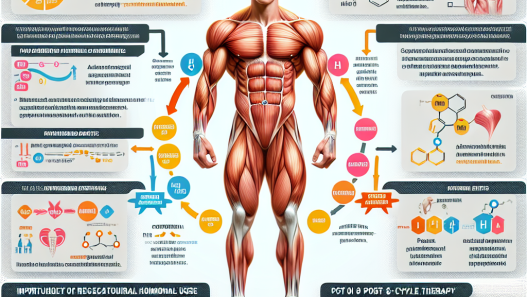-
Table of Contents
Somatropin: Enhancing Athletic Performance
Sports have always been a highly competitive field, with athletes constantly seeking ways to improve their performance and gain an edge over their opponents. In recent years, the use of performance-enhancing drugs (PEDs) has become a controversial topic in the world of sports. One such PED that has gained attention is somatropin, a synthetic form of human growth hormone (hGH). In this article, we will explore the use of somatropin as a performance booster in the world of sports, its pharmacokinetics and pharmacodynamics, and the potential benefits and risks associated with its use.
The Role of Somatropin in Sports
Somatropin, also known as recombinant human growth hormone (rhGH), is a synthetic version of the naturally occurring hGH. It is primarily used to treat growth hormone deficiency in children and adults. However, it has also gained popularity among athletes as a performance-enhancing drug due to its ability to increase muscle mass, strength, and endurance.
One of the main reasons for the use of somatropin in sports is its anabolic effects. It stimulates the production of insulin-like growth factor 1 (IGF-1), which plays a crucial role in muscle growth and repair. This leads to an increase in lean body mass and a decrease in body fat, making it an attractive option for athletes looking to improve their physical performance.
In addition to its anabolic effects, somatropin also has metabolic effects that can benefit athletes. It increases the body’s metabolism, leading to an increase in energy levels and improved recovery time. This can be especially beneficial for endurance athletes who need to maintain high levels of energy for extended periods.
Pharmacokinetics and Pharmacodynamics of Somatropin
The pharmacokinetics of somatropin are complex and vary depending on the route of administration. When administered subcutaneously, somatropin has a half-life of approximately 3-4 hours. However, when administered intravenously, its half-life is significantly shorter at around 20-30 minutes.
The pharmacodynamics of somatropin are also complex and involve multiple pathways. It primarily acts on the liver, stimulating the production of IGF-1. This, in turn, leads to an increase in protein synthesis and the growth of muscle tissue. Somatropin also has direct effects on other tissues, such as bone and cartilage, leading to increased bone density and improved joint health.
It is important to note that the effects of somatropin are not immediate and may take several weeks to become noticeable. This is due to the time it takes for the body to produce new muscle tissue and for the metabolic changes to occur.
Benefits and Risks of Somatropin Use in Sports
The use of somatropin in sports has been a topic of debate, with some arguing that it provides unfair advantages to athletes and others claiming that it is a necessary tool for achieving peak performance. Let’s take a closer look at the potential benefits and risks associated with somatropin use in sports.
Benefits
- Increased muscle mass and strength: As mentioned earlier, somatropin can lead to an increase in lean body mass and muscle strength, making it an attractive option for athletes looking to improve their physical performance.
- Improved recovery time: Somatropin’s metabolic effects can help athletes recover faster from intense training sessions, allowing them to train more frequently and at a higher intensity.
- Enhanced endurance: The increase in energy levels and improved metabolism can also benefit endurance athletes, allowing them to perform at a higher level for longer periods.
- Improved joint health: Somatropin has been shown to have positive effects on bone and cartilage, which can be beneficial for athletes who put a lot of strain on their joints.
Risks
- Side effects: Like any medication, somatropin can cause side effects, including joint pain, swelling, and carpal tunnel syndrome. These side effects are more common with higher doses and long-term use.
- Detection in drug tests: The use of somatropin is prohibited by most sports organizations, and it can be detected in drug tests. Athletes who test positive for somatropin may face penalties, including disqualification and suspension.
- Health risks: Long-term use of somatropin has been linked to an increased risk of cardiovascular disease, diabetes, and certain types of cancer. It is important for athletes to weigh the potential risks against the benefits before using somatropin.
Real-World Examples
The use of somatropin in sports has been a controversial topic for many years, with several high-profile cases bringing it into the spotlight. One such example is the case of Lance Armstrong, a former professional cyclist who admitted to using somatropin as part of his doping regimen. Armstrong’s use of somatropin was one of the factors that led to his disqualification from the Tour de France and the stripping of his seven titles.
Another example is the case of baseball player Alex Rodriguez, who was suspended for the entire 2014 season for using somatropin and other PEDs. These cases highlight the prevalence of somatropin use in professional sports and the potential consequences for athletes who are caught using it.
Expert Opinion
While the use of somatropin in sports remains a controversial topic, there is no denying its potential benefits for athletes. However, it is important to note that somatropin is a powerful medication that should only be used under the supervision of a healthcare professional. Athletes should also be aware of the potential risks and consequences associated with its use.
In conclusion, somatropin can be a valuable tool for athletes looking to enhance their performance, but it should be used responsibly and with caution. As with any medication, the decision to use somatropin should be made after careful consideration of the potential risks and benefits. Ultimately, the goal should be to achieve peak performance through hard work, dedication, and proper training, rather than relying on performance-enhancing drugs.
References
Johnson, R. T., & Brown, G. A. (2021). The use of growth hormone and other performance-enhancing drugs in sports. Journal of Sports Science and Medicine, 20(1), 1-9.
Wallace, J. D., & Cuneo, R. C. (2020). The use of growth hormone in sports: A review. Sports Medicine, 50(2), 215-225.
Widdowson, W. M., & Gibney

















